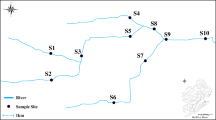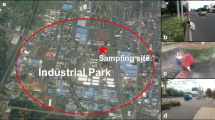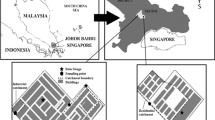Abstract
This study investigated the particulate matter (PM) and metals in highway dry deposition and rainfall-runoff as a function of hydrologic transport and settling on an event basis. Events were differentiated as mass-limited (ML) and flow-limited (FL). Results indicate that unique and separate suspended sediment concentration (SSC) relationships with turbidity occurred for ML and FL events. Sixty minutes of quiescent settling produced a single SSC-turbidity relationship for all events. ML events transport higher proportions of settleable and sediment PM while FL events transported relatively higher suspended PM. For batch clarification with one hour of settling, ML events had generally higher treatment efficiencies compared to FL events for the same settling conditions. Highway dry deposition PM was hetero-disperse and coarse (d 50 m = 304 μm). Results indicate that the acidic rainfall is not a significant contributor to metals in runoff but is capable of leaching metals from dry deposition PM into runoff. Partitioning in retained runoff resulted in a particulate-bound predominance for most metals except Ca and Mg. While the finer fraction of dry deposition PM (< 75 μm) generates the highest metal concentrations, the highest metal mass is associated with the coarser fraction (> 75 μm).
Similar content being viewed by others
References
Sansalone J, Ying G. Characteristics, transport and solubility of dry particulate metals deposited on urban highway area. Water Research, 2008, 42(15): 4146–4162
Colman J A, Friesz P J. Geohydrology and limnology of Walden Pond, Concord, Massachusetts. U.S. Geological Survey Water-Resources Investigations Report 01-4137, 2001, 61
Drapper D, Tominson R, Williams P. Pollutant concentrations in road runoff: Southeast queensland case study. Journal of Environmental Engineering, 2000, 126(4): 313–320
Lee J G, Heaney J P. Estimation of urban imperviousness and its impacts on storm water systems. Journal of Water Resources Planning and Management, 2003, 129(5): 429–426
Muschack W. Pollution of street run-off by traffic and local conditions. Science of the Total Environment, 1990, 93: 419–431
Sansalone JJ, Buchberger S G. Partitioning and first flush of metals in urban roadway storm water. Journal of Environmental Engineering, 1997, 123(2): 134–143
Sansalone J J, Koran J M, Smithson J A. Physical characteristics of urban roadway solids transported during rain event. Journal of Environmental Engineering, 1998, 124(5): 427–440
Sansalone J J, Cristina C M. First flush concepts for suspended and dissolved solids in small impervious watersheds. Journal of Environmental Engineering, 2004, 130(11): 1301–1314
Motelay-Massei A, Ollivon D, Tiphagne K, Garban B. Atmospheric bulk deposition of trace metals to the seine river basin: Concentrations, sources and evolution from 1998 to 2001 in Paris. Water, Air, and Soil Pollution, 2005, 164: 119135
Shaheen D. Contribution of Urban Roadway Usage to Water Pollution. EPA-600/2-75-004, United States Environmental Protection Agency (USEPA). 1975
Ellis J B, Revitt D M, Harrop D O, Beckwith P R. The contribution of highway surfaces to urban stormwater sediments and metal loadings. The Science of the Total Environment, 1987, 59: 339–349
Yousef Y A, Hvitved-Jacobsen T, Wanielista M P, Harper H H. Removal of contaminants in highway runoff through Swales. The Science of the Total Environment, 1987, 59: 391–397
Grant S B, Rekhi N V, Pise N R, Reeves R L. A Review of the Contaminants and Toxicity Associated With Particles in Stormwater Runoff. CTSW-RT-03-059.73.15, California Department of Transportation. 2003
Cristina C M, Sansalone J J. “First Flush,” power law and particle separation diagrams for urban storm-water suspended particulates. Journal of Environmental Engineering, 2003, 129(4): 298–307
Gray J R, Glysson D, Turcios L, Schwarz G. Comparability of suspended-sediment concentration and total suspended solids data. Water-Resources Investigation Report 00-4191, USGS. 2000
Bent G C. Effects of forest-management activities on runoff components and ground-water recharge to Quabbin Reservoir, Central Massachusetts. Forest Ecology and Management, 2001, 143(1–3): 115–129
ASTM. Standard Practice for Classification of Soils for Engineering Purposes, D2487-06. Pennsylvania: ASTM International, West Conshohocken, 2002
Lewis J. Turbidity-controlled suspended sediment sampling for runoff-event load estimation. Water Resources Research, 1996, 32(7): 2299–2310
Gippel C J. The use of turbidimeters in suspended sediment research. Hydrobiologia, 1989, 77: 465–480
USEPA. USEPA Issue Paper—Measurement of TSS in Runoff. United States Environmental Protection Agency (USEPA), I:189-FR977001, URS Greiner Woodward Clyde. 1999
Gippel C J. Potential of turbidity monitoring for measuring the transport of suspended solids in streams. Hydrological Processes, 1995, 9: 83–97
Packman, J J, Comings K J, Booth D B. Using turbidity to determine total suspended solids in urbanizing streams in the Puget Lowlands. Vancouver, B C: Canadian Water Resources Association annual meeting, 1999, 158–165
Kim J Y, Sansalone J. Event-based size distributions of particulate matter transported during urban rainfall-runoff events. Water Research, 2008, 42: 2756–2768
ASTM. Standard Practice for Dry Preparation of Soil Samples for Particle-Size Analysis and Determination of Soil Constants. West Conshohocken, Pa, 1993, Vol. 04 and 08
Ying G, Sansalone J. Granulometric relationships for urban source area runoff as a function of hydrologic event classification and sedimentation. Water, Air, & Soil Pollution, 2008, 193(1): 229–246
Dean C M, Sansalone J J, Cartledge F K, Pardue J H. Influence of hydrology on rainfall-runoff metal element speciation. Journal of Environmental Engineering, 2005, 131(4): 632–642
Author information
Authors and Affiliations
Corresponding author
Rights and permissions
About this article
Cite this article
Ying, G., Sansalone, J.J. Particulate matter and metals partitioning in highway rainfall-runoff. Front. Environ. Sci. Eng. China 4, 35–46 (2010). https://doi.org/10.1007/s11783-010-0009-4
Received:
Accepted:
Published:
Issue Date:
DOI: https://doi.org/10.1007/s11783-010-0009-4




